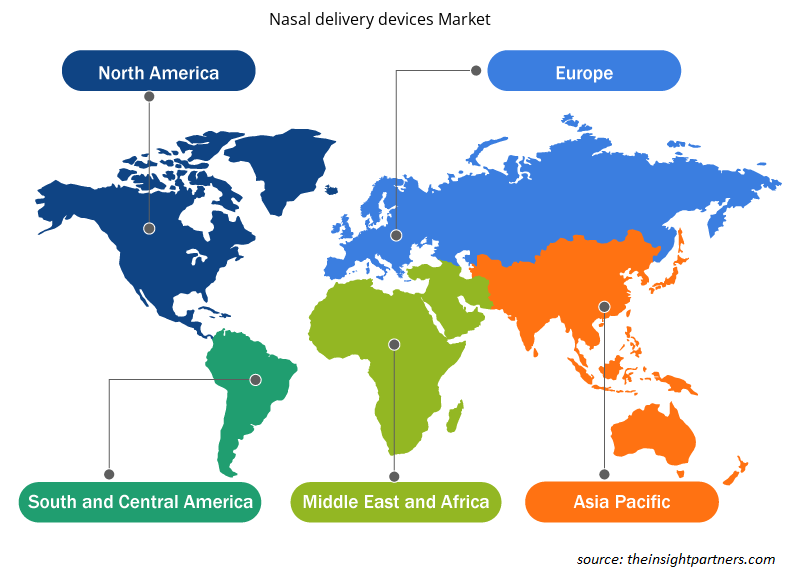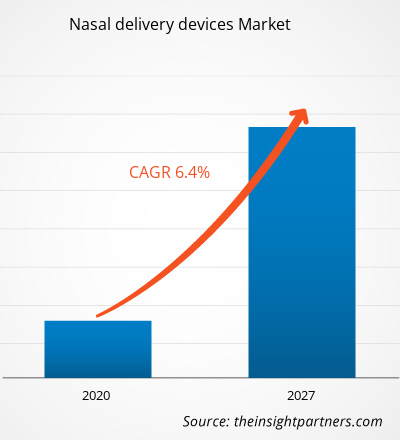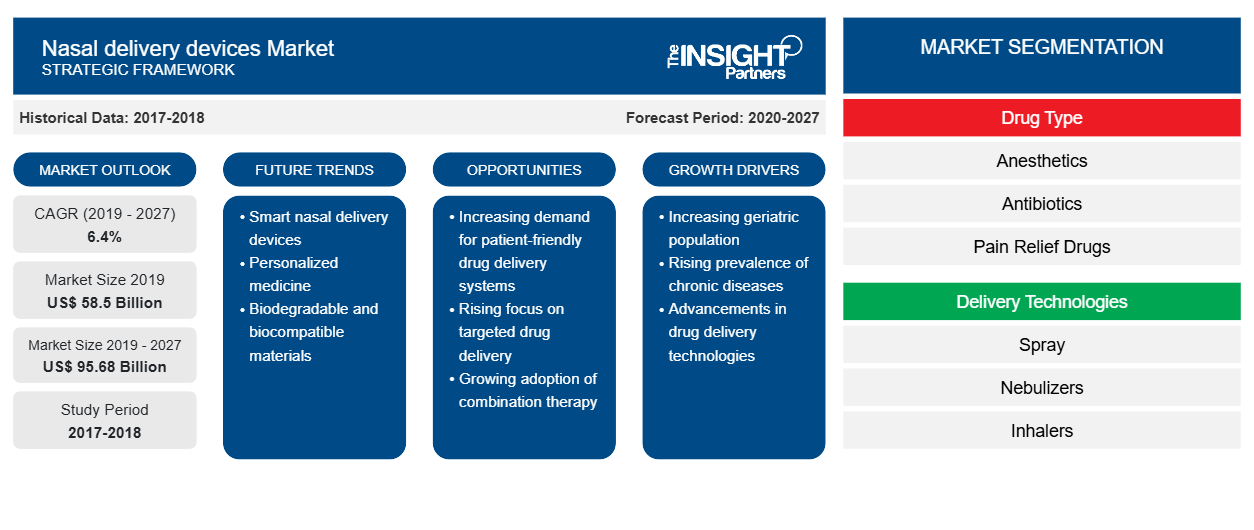Der Markt für nasale Verabreichungsgeräte soll von 58.502,18 Millionen US-Dollar im Jahr 2019 auf 95.676,62 Millionen US-Dollar im Jahr 2027 anwachsen. Der Markt soll von 2020 bis 2027 mit einer durchschnittlichen jährlichen Wachstumsrate von 6,4 % wachsen.
Die nasale Verabreichung von Medikamenten ist eine der von Patienten und Gesundheitsdienstleistern bevorzugten Verabreichungsmethoden. Dies ist hauptsächlich auf die nichtinvasive Natur dieser Verabreichungsmethode und die bessere Absorptionsfähigkeit der Medikamente über die Nase zurückzuführen. Darüber hinaus bietet die nasale Verabreichungsmethode im Vergleich zur gastrointestinalen Verabreichungsmethode eine weniger feindliche Umgebung für Medikamente, wodurch eine bessere Absorption der Medikamente ermöglicht wird. Die einfache Verabreichung dieser Medikamente spielt eine entscheidende Rolle bei der Verbesserung der Compliance der Patienten mit Arzneimitteltherapien, was wiederum zu den Behandlungsergebnissen der Patienten beiträgt. In Anbetracht dieser Faktoren wird die nasale Verabreichung von Medikamenten sowohl von Patienten als auch von Gesundheitsdienstleistern immer beliebter. Da die Nasenhöhle stark durchblutet ist, wird die Absorption der Medikamente verbessert, was zu einer schnellen Wirkung führt. Die Weltgesundheitsorganisation (WHO) hat spezielle Richtlinien für Hersteller, in denen alle notwendigen Anforderungen für die Einführung neuer nasaler Verabreichungsgeräte mit einem Einweg-Verabreichungssystem dargelegt sind. Daher erfordert die nasale Verabreichung von Medikamenten im Gegensatz zu anderen Verabreichungsmethoden keine strengen sterilen Methoden zur Verabreichung von Medikamenten in den Körper. Daher ist die hohe Präferenz der Patienten und des medizinischen Personals für die nasale Verabreichung von Medikamenten aufgrund des wachsenden Bewusstseins hinsichtlich ihrer Vorteile der Motor des Marktwachstums.
Passen Sie diesen Bericht Ihren Anforderungen an
Sie erhalten kostenlos individuelle Anpassungen an jedem Bericht, einschließlich Teilen dieses Berichts oder einer Analyse auf Länderebene, eines Excel-Datenpakets sowie tolle Angebote und Rabatte für Start-ups und Universitäten.
-
Holen Sie sich die wichtigsten Markttrends aus diesem Bericht.Dieses KOSTENLOSE Beispiel umfasst eine Datenanalyse von Markttrends bis hin zu Schätzungen und Prognosen.
Markteinblicke
Zunehmende Prävalenz von Atemwegs- und ZNS-Erkrankungen
Die ersten Proof-of-Concept-Studien mit neuartigen nasalen Medikamentenverabreichungsgeräten zeigten vielversprechende Ergebnisse bei der Behandlung von Atemwegserkrankungen, neurologischen Störungen und anderen Erkrankungen. Medikamentenverabreichungsgeräte spielen eine wesentliche Rolle bei der Sicherstellung der Abgabe des gesamten Medikaments an die Zielstelle in der Nasenhöhle. In den letzten Jahrzehnten wurden mehrere innovative Ansätze zur Medikamentenverabreichung eingeführt, die die Herausforderungen beim Überwinden der Blut-Hirn-Schranke (BBB) überwinden könnten. Mehrere wissenschaftliche Studien stützen die Spekulation, dass die Verabreichung von Medikamenten über die Nase es ermöglichen könnte, dass höhere Konzentrationen von Medikamenten die BBB passieren. Die steigende Inzidenz neurologischer Störungen würde die Nachfrage nach nasalen Verabreichungsgeräten erhöhen. Laut der American Society of Clinical Oncology (ASCO) wurden im Jahr 2020 in den USA bei Kindern im Alter von 0–14 Jahren etwa 3.540 Hirn- und andere ZNS-Tumore diagnostiziert. Der Bericht stellte auch fest, dass Hirn- und andere ZNS-Tumore die zweithäufigsten Krebsarten bei Kindern sind und etwa 26 % der Krebsfälle bei Kindern unter 15 Jahren ausmachen.
Atemwegserkrankungen wie akute Infektionen der unteren Atemwege, Tuberkulose, chronisch obstruktive Lungenerkrankung (COPD – ein Krankheitsspektrum, das Bronchitis und Emphysem umfasst), Asthma und Lungenkrebs gehören weltweit zu den häufigsten Ursachen für schwere Erkrankungen und Todesfälle. Zunehmende Urbanisierung und Umweltverschmutzung, ungesunder Lebensstil und Gewohnheiten sowie hohe Tabakrauchquote sind einige der Faktoren, die zu einem Anstieg der Fälle von Atemwegs- und Herz-Kreislauf-Erkrankungen führen. Die Atemwege können akutes Atemversagen verursachen, dessen Behandlung eine kontinuierliche nasale Medikamentengabe erfordert. Laut dem Global Asthma Report 2018, der vom Global Asthma Network veröffentlicht wurde, leiden weltweit etwa 330 Millionen Menschen an Asthma. Darüber hinaus starben im Jahr 2016 nach Schätzungen von Global Burden of Disease, einem speziellen Forschungsprojekt des Institute for Health Metrics and Evaluation, etwa 420.000 Menschen an Asthma. Laut einer 2018 in der US National Library of Medicine National Institutes of Health veröffentlichten Studie ist die Asthmaprävalenz in Korea konstant hoch, insbesondere unter Frauen und älteren Menschen. Darüber hinaus gab es laut dem Bericht Global Burden of Disease Study im Jahr 2016 251 Millionen COPD-Fälle. Mehr als 90 % der COPD-Todesfälle ereignen sich in Ländern mit niedrigem und mittlerem Einkommen (LMICs), und die Krankheit dürfte in den nächsten 15 Jahren zu einer der häufigsten Todesursachen weltweit werden.
Daher steigert die zunehmende Verbreitung von Atemwegserkrankungen, neurologischen Störungen und anderen chronischen Krankheiten die Nachfrage nach nasalen Verabreichungsgeräten für eine wirksame Verabreichung von Medikamenten an die Zielorte.
Einblicke in Arzneimitteltypen
Basierend auf dem Medikamententyp ist der Markt für nasale Verabreichungsgeräte in Anästhetika, Antibiotika, Schmerzmittel, Kalziumpräparate, Vasokonstriktoren, Antihistaminika und andere unterteilt. Im Jahr 2019 hatte das Segment der Antihistaminika den größten Marktanteil. Das Wachstum dieses Segments ist auf die Zunahme allergischer Rhinitis zurückzuführen.
Einblicke in Liefertechnologien
Basierend auf den Verabreichungstechnologien ist der globale Markt für nasale Verabreichungsgeräte in Sprays, Vernebler, Inhalatoren und andere unterteilt. Im Jahr 2019 hielt das Inhalatorensegment einen großen Marktanteil und wird im Prognosezeitraum voraussichtlich die höchste durchschnittliche jährliche Wachstumsrate auf dem Markt verzeichnen.
Erkenntnisse für Endbenutzer
Basierend auf dem Endverbraucher ist der globale Markt für nasale Verabreichungsgeräte in häusliche Pflegeeinrichtungen, Krankenhäuser und Kliniken unterteilt. Im Jahr 2019 hielt das Segment der häuslichen Pflegeeinrichtungen einen großen Marktanteil und wird im Prognosezeitraum voraussichtlich die höchste durchschnittliche jährliche Wachstumsrate des Marktes verzeichnen.
Produkteinführungen und Zulassungen sind die von Unternehmen häufig verfolgten Strategien, um ihre globale Präsenz und ihr Produktportfolio zu erweitern und der wachsenden Verbrauchernachfrage gerecht zu werden. Die Marktteilnehmer für nasale Verabreichungsgeräte verfolgen die Strategie der Zusammenarbeit, um ihren Kundenstamm weltweit zu vergrößern, was ihnen auch ermöglicht, ihren Markennamen weltweit aufrechtzuerhalten.
Markt für nasale Verabreichungsgeräte – regionale Einblicke
Die regionalen Trends und Faktoren, die den Markt für nasale Verabreichungsgeräte während des gesamten Prognosezeitraums beeinflussen, wurden von den Analysten von Insight Partners ausführlich erläutert. In diesem Abschnitt werden auch die Marktsegmente und die Geografie für nasale Verabreichungsgeräte in Nordamerika, Europa, im asiatisch-pazifischen Raum, im Nahen Osten und Afrika sowie in Süd- und Mittelamerika erörtert.

- Erhalten Sie regionale Daten zum Markt für nasale Verabreichungsgeräte
Umfang des Marktberichts zu nasalen Verabreichungsgeräten
| Berichtsattribut | Details |
|---|---|
| Marktgröße im Jahr 2019 | 58,5 Milliarden US-Dollar |
| Marktgröße bis 2027 | 95,68 Milliarden US-Dollar |
| Globale CAGR (2019 - 2027) | 6,4 % |
| Historische Daten | 2017-2018 |
| Prognosezeitraum | 2020–2027 |
| Abgedeckte Segmente |
Nach Arzneimitteltyp
|
| Abgedeckte Regionen und Länder |
Nordamerika
|
| Marktführer und wichtige Unternehmensprofile |
|
Dichte der Marktteilnehmer für nasale Verabreichungsgeräte: Die Auswirkungen auf die Geschäftsdynamik verstehen
Der Markt für nasale Verabreichungsgeräte wächst rasant, angetrieben durch die steigende Nachfrage der Endnutzer aufgrund von Faktoren wie sich entwickelnden Verbraucherpräferenzen, technologischen Fortschritten und einem größeren Bewusstsein für die Vorteile des Produkts. Mit steigender Nachfrage erweitern Unternehmen ihr Angebot, entwickeln Innovationen, um die Bedürfnisse der Verbraucher zu erfüllen, und nutzen neue Trends, was das Marktwachstum weiter ankurbelt.
Die Marktteilnehmerdichte bezieht sich auf die Verteilung der Firmen oder Unternehmen, die in einem bestimmten Markt oder einer bestimmten Branche tätig sind. Sie gibt an, wie viele Wettbewerber (Marktteilnehmer) in einem bestimmten Marktraum im Verhältnis zu seiner Größe oder seinem gesamten Marktwert präsent sind.
Die wichtigsten Unternehmen auf dem Markt für nasale Verabreichungsgeräte sind:
- GlaxoSmithKline plc.
- AstraZeneca
- Pfizer Inc.
- BD
- Sanofi
Haftungsausschluss : Die oben aufgeführten Unternehmen sind nicht in einer bestimmten Reihenfolge aufgeführt.

- Überblick über die wichtigsten Akteure auf dem Markt für nasale Verabreichungsgeräte
Markt für nasale Verabreichungsgeräte – nach Arzneimitteltyp
- Anästhetika
- Antibiotika
- Schmerzmittel
- Kalziumpräparate
- Vasokonstriktoren
- Antihistaminika
- Sonstiges
Markt für nasale Verabreichungsgeräte – nach Verabreichungstechnologien
- Spray
- Vernebler
- Inhalatoren
- Sonstiges
Markt für nasale Verabreichungsgeräte – nach Endbenutzer
- Einstellungen für die häusliche Pflege
- Krankenhäuser
- Kliniken
Markt für nasale Verabreichungsgeräte – nach Geografie
-
Nordamerika
- UNS
- Kanada
- Mexiko
-
Europa
- Frankreich
- Deutschland
- Italien
- Vereinigtes Königreich
- Spanien
- Restliches Europa
-
Asien-Pazifik (APAC)
- China
- Indien
- Südkorea
- Japan
- Australien
- Restlicher Asien-Pazifik-Raum
-
Naher Osten und Afrika (MEA)
- Südafrika
- Saudi-Arabien
- Vereinigte Arabische Emirate
- Restlicher Naher Osten und Afrika
-
Süd- und Mittelamerika
- Brasilien
- Argentinien
- Restliches Südamerika
Firmenprofile
- GlaxoSmithKline plc.
- AstraZeneca
- Pfizer Inc
- BD
- Sanofi
- Merck & Co., Inc.
- Cadila Pharmaceuticals Ltd.
- Novartis AG
- Dr. Reddys Laboratorien
- Neurelis, Inc
- Historische Analyse (2 Jahre), Basisjahr, Prognose (7 Jahre) mit CAGR
- PEST- und SWOT-Analyse
- Marktgröße Wert/Volumen – Global, Regional, Land
- Branchen- und Wettbewerbslandschaft
- Excel-Datensatz
Aktuelle Berichte
Verwandte Berichte
Erfahrungsberichte
Grund zum Kauf
- Fundierte Entscheidungsfindung
- Marktdynamik verstehen
- Wettbewerbsanalyse
- Kundeneinblicke
- Marktprognosen
- Risikominimierung
- Strategische Planung
- Investitionsbegründung
- Identifizierung neuer Märkte
- Verbesserung von Marketingstrategien
- Steigerung der Betriebseffizienz
- Anpassung an regulatorische Trends























 Kostenlose Probe anfordern für - Markt für nasale Verabreichungsgeräte
Kostenlose Probe anfordern für - Markt für nasale Verabreichungsgeräte